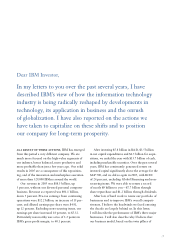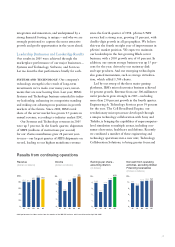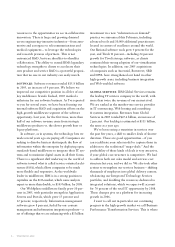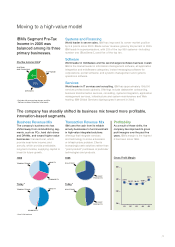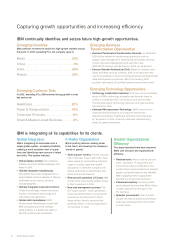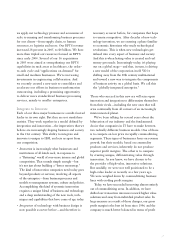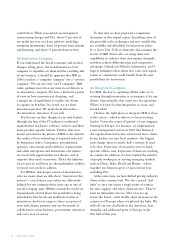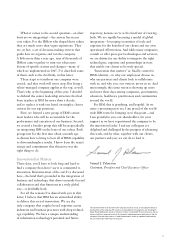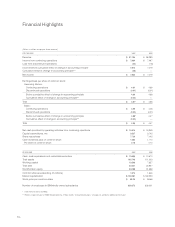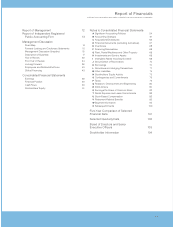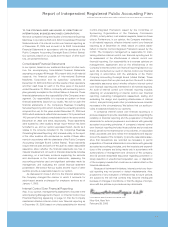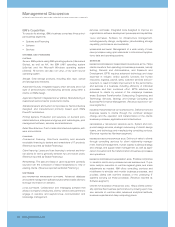IBM 2005 Annual Report Download - page 9
Download and view the complete annual report
Please find page 9 of the 2005 IBM annual report below. You can navigate through the pages in the report by either clicking on the pages listed below, or by using the keyword search tool below to find specific information within the annual report.To that end, we have prepared a companion
document to this annual report, describing some of
the powerful tools, techniques and new models that
are available and affordable for innovators today.
It’s a Great Time To Be an Innovator also contains the
stories of IBM clients who are using these new
capabilities to enhance their own unique strengths
and thus achieve differentiation and competitive
advantage. I think you’ll find it informative, and I
hope it stimulates ideas about how your own organi-
zation or community could benefit from the new
possibilities for innovation.
An Integrated Company
For IBM, the key to capturing all this value we’re
creating through innovation is to integrate it for our
clients. Operationally, that raises two key questions:
Where is it best for that integration to occur, and
around what?
I believe the right place to integrate IBM is close
to the action
—
which is why we’ve been working
hard to “lower the center of gravity” of our company.
Starting in Europe, for instance, we implemented
a new management system in 2005 that flattened
the organizational structure and moved more client-
facing leaders out into local markets
—
the biggest
such change there in nearly half a century. It used
to be that 44 percent of executives were in head-
quarters offices; now, 84 percent of them are working
in-country. In addition, we have tripled the number
of people working in or serving emerging markets
such as China, India, Brazil and Russia
—
where
together our business grew 23 percent last year,
excluding PCs.
At the same time, we have shifted pricing authority
down to the country level. We also created “deal
hubs” to give our teams a single point of contact
for sales support and other client services. They’ve
been an immediate success. Win rates are up
across the board
—
with double-digit increases in the
countries of Europe where we piloted the hubs. We
will roll out new deal hubs in the Americas, Asia,
Australia and additional parts of Europe in the
first half of this year.
contribution. When you exclude second-quarter
restructuring charges and PCs, about 37 percent of
our profit last year was from software, including
enterprise investments; about 28 percent from systems
and financing; and about 35 percent from services.
An Innovation Company
If you understand the broad economic and societal
changes taking place, the transformation of our
company to capitalize on them and the resulting mix
of our business, it should be apparent that IBM in
2006 is neither a “computer company” nor a “services
company.” We are not even “an IT company.” IBM
today, perhaps more than any time in our history, is
an innovation company. We have a distinctive point
of view on how innovation is changing, and
a unique set of capabilities to enable our clients
to capture its benefits. In a word, we are their
innovation partner. We make them innovative
—
the innovators’ innovator, if you will.
You’d never see this, though, if you only looked
through the lens of the IT industry’s traditional
segmentation: hardware, software, services and their
many product-specific subsets. Further, that view
doesn’t just obscure the picture of IBM; it also distorts
the reality of how technology is acquired and used
by businesses today. Companies, governmental
agencies, educational and healthcare organizations
and other enterprises and institutions everywhere
are faced with opportunities and threats, and in
response they need to innovate. That’s the industry
we are part of, and those are the marketplace realities
everyone in it needs to address.
For IBMers, this deeper notion of innovation is
what we mean when we talk about “innovation that
matters”
—
one of three core values we collectively
defined for our company three years ago in one of
our all-company jams. IBMers around the world are
tremendously excited about the possibilities being
unlocked by this broad and ambitious notion of
innovation. And we’re eager to share our point of
view with clients, partners and our thousands of
collaborators across business, government, education
and every area of society.
8_ Chairman’s Letter


